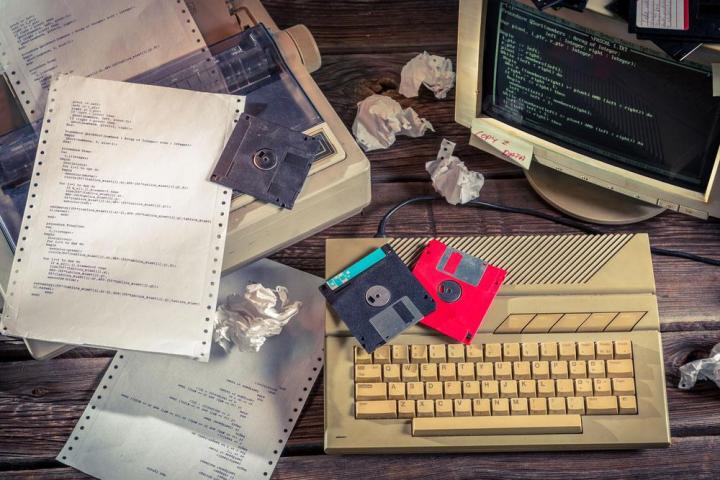
Sony CFDS50 CD and Cassette Boombox with FM/AM radio ($50)

Sony advertises this boombox as “equipped with everything you need,” but to be honest, it’s pretty much equipped with everything you might need two decades ago. It retails for a mere $50 and comes outfitted with a CD and cassette player, along with an AM-FM radio that will surely have you fumbling for the antenna regardless of the weather overhead. You can even take this bad boy with you on-the-go, assuming you have six C batteries laying around the house. But, in emergency situations where electricity isn’t available, radios like this can be lifesavers.
Royal Epoch Manual Typewriter ($200)

Typewriters were the workhorses for most of the 20th-century. Yet, despite the arrival of computer-based word processing, typewriters have endured. We imagine most of them are being used by aspiring authors and poets, or conspiracy theorists with an innate distrust of the Web and technology. For these folks, there’s the Royal Epoch, a prime example that offers the age-old click and clack of a traditional typewriter, although we aren’t sure if it’s for function or decoration.
Nikon FM-10 35mm SLR analog film camera ($570)

Finding a new 35mm-film SLR may seem like a tall order. However, Nikon still sells its manual FM10 – which hasn’t changed since 1995 – while Fujifilm continues to produce and sell the wide-angle Klasse W in Japan. They utilize film and allow access to manual exposure controls, though, they aren’t as useful when it comes to capturing duck-faced selfies. But, like younger generations rediscovering vinyl records, there’s a small but growing interest for film cameras (Lomography has plenty of film cameras to sell you). And, many professionals enjoy the creative aspects and image quality that only analog can produce.
Morgan 4/4 ($38.646)

Nearly 80 years ago, the Morgan Motor Company debuted the 4/4. As the name might imply, the 4/4 donned four separate wheels, which was also a first for the English automaker. The two-seater was initially updated in 1955 and again in 2009, but it has always retained its classic design through each iteration. The engine and gearbox have been given an overhaul, though, making the vintage coup’s $38,000 price tag a bit more reasonable.
Casio DBC32-1A Data Bank Watch ($25)

The wristwatch industry may be in the midst of a major shakeup given the the recent release of the Apple Watch, but Casio’s iconic calculator wristwatch has endured since the 1980s. Casio’s Data Bank is designed to last years instead of mere hours, though, while conveniently providing you with a digital phonebook, calendar, and calculator to match. It won’t burden you with notifications or calls, either, which kind of makes it function akin to your typical smartwatch when in “Do Not Disturb Mode.” Right?
Next Page: 5 more pieces of retro tech
Epson LX-350 Dot Matrix Impact Printer ($231)

Known as an “impact printer,” the LX-360 uses the old dot-matrix printing technology that was common prior to inkjet and laser. These printers have that recognizable (and audible) feature of a printhead moving left and right to heat ink from a ribbon onto paper that’s slowly fed upward. It even supports legacy connectors like parallel. Despite being replaced by faster technologies that produce greater image quality, Epson still sells them. The LX-360 is actually one of several models, and they can cost as much $3,000 when purchased direct from Epson. While you won’t see these in homes any more, they are still used in IT security, business, and government.
Sharp UX355L standalone fax machine ($350)

In their heyday, standalone fax machines were the bread and butter of business correspondence. You would think their usefulness should have faded long ago with the rise of email and the onset of the paperless era, but they still are heavily used in business and government. Fax lines are deemed more secured than Internet, and fax documents are considered legal-binding, such as contracts and medical records. Which is why big companies like Sharp and Canon continue to produce them, like the Sharp UX355L. Fax capabilities are also built into all-in-one printers, so it may be a while before this technology disappears.
Floppy disks ($10)

Everyone knows floppy disks are a relic of a bygone era, so why do office suppliers still sell the aging technology? Many computers manufactured today don’t even read optical discs, let alone their squared counterparts. Perhaps there’s a bar somewhere using floppies as beer coasters, conveniently breathing life into the magnetic storage medium that was nearly forgotten. Believe or not, there are businesses and government agencies that still rely on them; even the tech-savvy Obama administration can’t get rid of this antiquated storage format. Whatever the reason, a 10-pack of floppies will cost you a mere $9 on retail sites like Amazon and Newegg.
AOL dial-up Internet ($15/month)

Incredibly, more than 2 million people still subscribe to AOL’s Internet dial-up service. According to the Federal Communications Commission (FCC), 3-percent of the U.S. population still use their telephone lines to dial into the Web. While there’s a push to get everyone onto broadband, infrastructure (e.g., rural areas) and income are reasons why the technology still exists. But the big question remains: is AOL still sending the free CDs through the mail?
Pay phones

According to the American Public Communications Council, less than half-a-million pay phones are still operating in the United States. With cell phones seemingly in everyone’s pockets, the thought of putting a germ-infested headset to your face can be traumatizing. But they are convenient, like when a tourist needs to make a call or your smartphone’s battery is spent. Some companies are turning pay phone kiosks into Internet terminals that offer more functionality. Regardless of their reason for sticking around, their numbers are decreasing.


